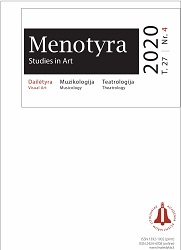Regentystės ornamentinis dekoras XVIII a. 3 dešimtmečio – XVIII a. vidurio liturginės tekstilės siuviniuose Lietuvoje
Regency Ornamental Décor in the Embroidery of Liturgical Textile in Lithuania from the 1720s to the Middle of the Eighteenth Century
Author(s): Svetlana PoligienėSubject(s): Museology & Heritage Studies, Visual Arts, 18th Century, History of Art
Published by: Lietuvos mokslų akademijos leidykla
Keywords: Regency; chinoiserie; ornament; liturgical vestments; embroidery;
Summary/Abstract: The article presents and discusses the so far poorly explored group of the embroidery of liturgical textile of the 1720s to the mid-eighteenth century distinguished by the Regency style, the ornamental decoration of the late Baroque variety. The elements of chinoiserie stylistics of oriental origin and bizarre style fabrics are organically interwoven with the dominant classical features of the style: Regency-type interwoven stripes, cartouches, and fields combined with stars of anise, blossoms of bellflowers and tiny tulips, and other floral motifs. For this purpose, we chose items of liturgical textile extant in Lithuanian churches and stored in depositories of various museums; we as also “took a look” in Poland and Belarus, the neighbouring lands of the former Polish-Lithuanian Commonwealth) So far, the opinion has prevailed that we have only few items of liturgical textile decorated with embroidered Regency ornamental décor. However, the examples discussed in the text show that the statement needs to be revised. Indeed, a large amount of embroidery of this type has survived. The vestments from the early 1720s embroidered with the ornamental décor in the Regency style are distinct in ornamentation colours and technological changes against the general context of embroidered liturgical textiles of the period. The wares mentioned above enrich the depository of liturgical textile embroidery, and the mastery of the craft is superior to the examples found in neighbouring countries. The insights provided in the text suggest that in the future, the study could be expanded by further examination of the peculiarities of the period’s décor, its possible origin and interpretations, and the search for broader contextual links.
Journal: Menotyra
- Issue Year: 27/2020
- Issue No: 4
- Page Range: 259-276
- Page Count: 18
- Language: Lithuanian

